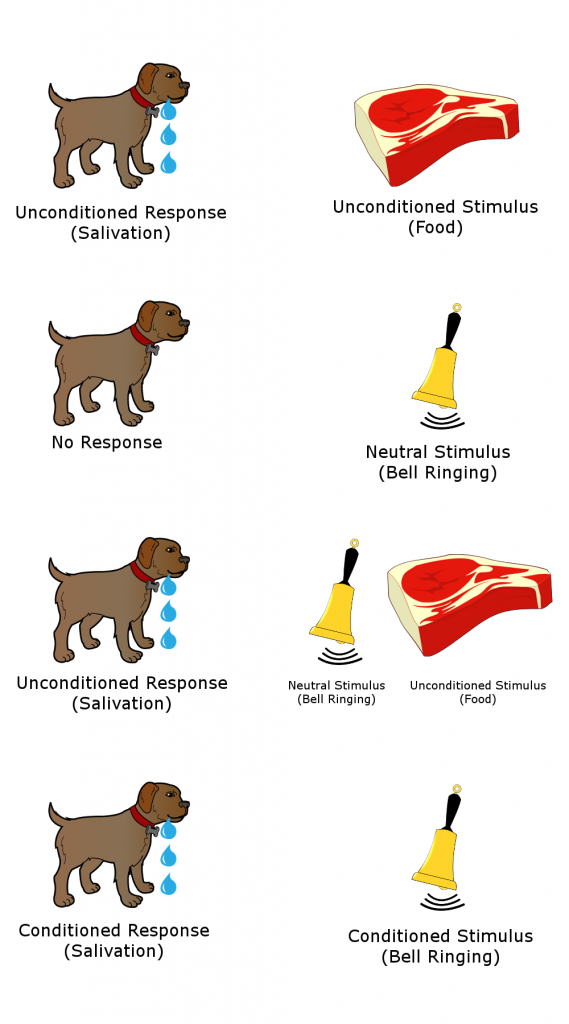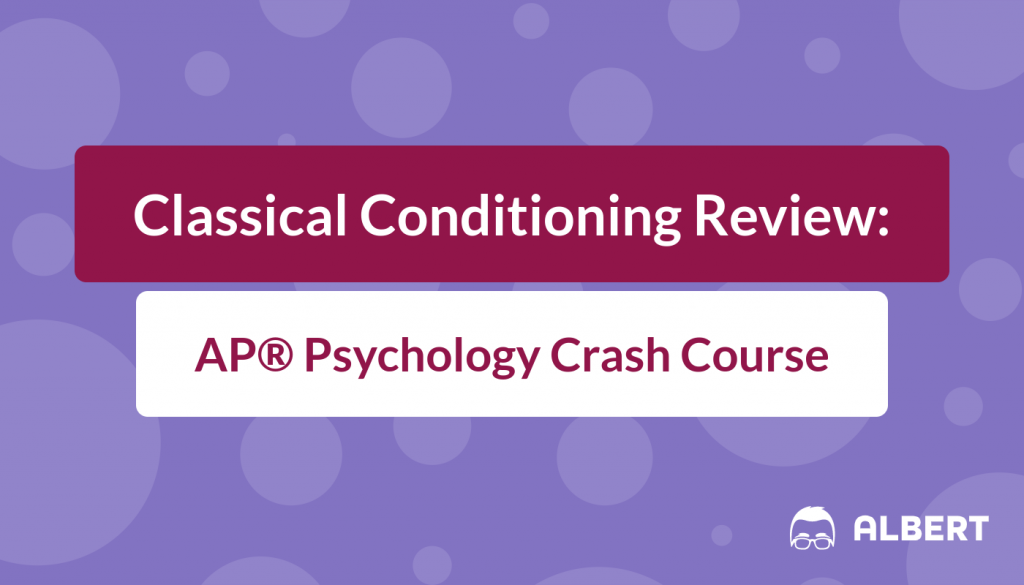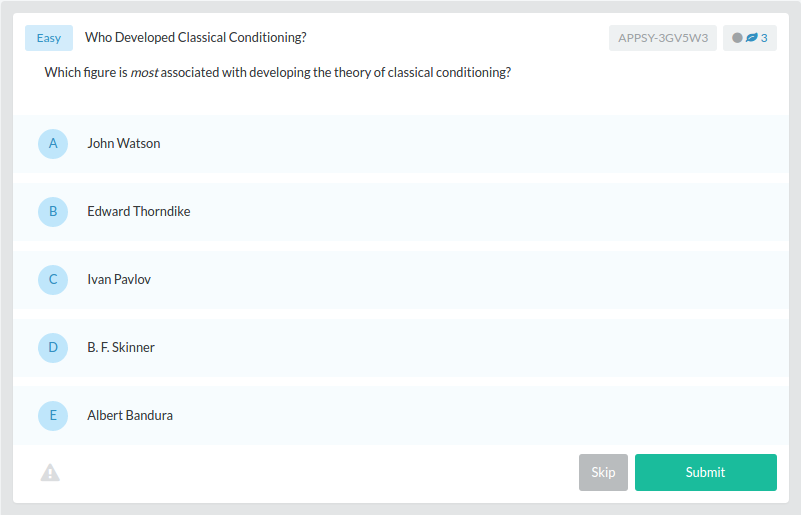What is Classical Conditioning?
Classical conditioning is a type of learning where the organism learns to associate two stimuli. Association begins when a neutral stimulus happens and an unconditioned stimulus produces a response. The unconditioned stimulus naturally and automatically triggers a response that psychologists call the unconditioned response. The unconditioned response is the unlearned, naturally occurring response to the unconditioned stimulus. Through classical conditioning the neutral stimulus is then associated to become the conditioned stimulus, causing a conditioned response. The conditioned response is reinforced as the process is repeated.
Being a type of associate learning, classical conditioning is all about bringing stimuli and responses together. This mode of learning looks at the effect that the stimuli has on organisms as well as the relationships made with the stimuli. Now, all of these terms can be a little confusing, so let’s look at some examples that utilize the idea of classical conditioning.
Example 1: Pavlov’s Dogs

The original experiment that Ivan Pavlov did to form this classical conditioning idea was with German Shepherds. Pavlov began the experiment by giving the dogs their food. The food is the unconditioned stimulus in this case. When introduced to the food the dogs began to salivate, which is the unconditioned response.
Then, Pavlov started to ring a bell every time before he introduced the food. The bell is the neutral stimulus and it is attributed to the food, the unconditioned stimulus, which results in the dogs salivating, or the unconditioned response. This association is called acquisition and must take place in order for classical conditioning to happen. Without acquisition the unconditioned stimulus and the conditioned stimulus will not be associated with each other. It is very important that the bell was rung every time to fortify this association.
Once the dogs fully associate the food with the bell, then the dogs will salivate whenever the bell is rung. This makes the bell the conditioned stimulus and the salivation the conditioned response.
Example 2: Scent Association
Classical conditioning, however, is not just for training dogs. Let’s look at another example of classical conditioning that uses humans. The subject, we will call him Dave, went on a date last night, and his date wore cologne. The date turned very passionate. When Dave got in his car and smelled the remnants of the cologne he became overcome with excitement and happiness.
Here the unconditioned stimulus would be the passionate date, which led to the unconditioned response of an exciting and happy reaction. When the cologne is introduced it becomes the conditioned stimulus, or the stimulus that is attributed to the passionate date. The cologne then triggers the happy and excited reaction, or the conditioned response.
This response of happiness and excitement may fade in time, or become extinct. Extinction happens, because the unconditioned stimulus of the passionate date is no longer associated with each other. An example of this may be when the next date does not go well. After that, Dave may no longer get excited when he smells the cologne.
Although, if Dave and his date have another passionate date after extinction has occurred, then spontaneous recovery could happen. This means that Dave may once again learn to associate the cologne with a passionate date.
Example 3: Bitten
Jane was walking down the street when she was bitten by a German Shepherd. Now whenever she walks down the street and sees that dog she becomes fearful. Jane, however, is not afraid of her own dog at home.
The unconditioned stimulus here is the bite from an English Bulldog. The unconditioned response to that bite is fear. When she walks down the street and sees the dog again, then that is the conditioned stimulus. As Jane sees that dog she becomes fearful. That fear is the conditioned response. Now every time Jane sees that dog she will become afraid.
The reason that Jane is not afraid of her own dog at home is a term called discrimination. Here discrimination means that Jane can distinguish between the dog that has made her fearful and her own dog. She separates the two entities and does not make a connection between all dogs and fear.
If Jane had made the connection with fear to all dogs, a phenomenon called generalization, then she would have been fearful of her dog as well.
Why is Classical Conditioning Important for the AP® Psychology Exam?
Ivan Pavlov’s classical conditioning is very important to the AP® Psychology exam, because the open ended portion of the exam often contains questions about identifying the learning style in a certain scenario. This means that student may be given a scenario that involves one of the styles of learning that may include classical conditioning. Being able to pick out the unconditioned stimulus, unconditioned response, conditioned stimulus, and conditioned response could determine the difference between a score of a 3 or of a 5.
Classical conditioning is on the AP® Psychology exam so often in the free response questions as well as the multiple choice section, because the AP® Psychology exam puts an emphasis on psychology as a science, and the classical conditioning experiments done by Pavlov exemplify this idea. Pavlov’s experiments and conclusions also gave a springboard for B.F. Skinner to come along and perform his experiments of operant conditioning.
Knowing the difference between classical conditioning and its other learning counterparts such as operant conditioning and observational learning will really showcase your knowledge.
Wrapping Up Classical Conditioning and AP® Psychology
Classical conditioning is vital for the AP® Psychology exam. You need to be able to recognize if classical conditioning is occurring. A great way to do that is to be able to identify the unconditioned stimulus, the unconditioned response, the conditioned stimulus, and the conditioned response. If you cannot relate those terms to the prompt, then you may not be looking at classical conditioning. Other terms that will be helpful are generalization, discrimination, extinction, and spontaneous recovery. Knowing all of these terms will be sure to assist your answering the multiple choice section of the AP® Psychology exam.
Let’s put everything into practice. Try this AP® Psychology practice question:
Looking for more AP® Psychology practice?
Check out our other articles on AP® Psychology.
You can also find thousands of practice questions on Albert.io. Albert.io lets you customize your learning experience to target practice where you need the most help. We’ll give you challenging practice questions to help you achieve mastery of AP Psychology.
Start practicing here.
Are you a teacher or administrator interested in boosting AP® Psychology student outcomes?
Learn more about our school licenses here.









